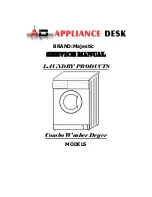
16
SORTING WASH LOADS
CAUTION
•
Do not load items higher than the top edge of the tub.
Failure to follow this caution can result in leakage or
damage to fabrics.
•
Use the BULKY/BEDDING cycle for buoyant or
nonabsorbent items such as pillows or comforters. Failure to
follow this caution can result in leakage.
•
Do not wash or spin any item labeled or known to be
water-proof or water-resistant, even if the product care
label on the item permits machine washing.
Failure to
follow these instructions could result in bodily injury, severe
damage to your laundry, your washer and/or property
damage as a result of abnormal vibration of the washer.
- Examples of water-proof or water-resistant items include
certain mattress pads, mattress covers, rain gear, camping
gear, skiing apparel , outdoor gear and similar items.
Grouping Similar Items
For the best washing results, and to reduce the possibility of
damage to clothing, care should be taken to sort the
clothing into loads that are made up of similar items.
in poor wash performance, color transfer or discoloration,
fabric damage or linting. Fabrics should be sorted into
groups as described below.
Colors
Sort articles by color. Wash dark clothes together in a
separate load from light colors or whites. Mixing dark
clothes with light clothes can result in dye transfer or
discoloration of the lighter clothes.
Soil Level
Wash heavily soiled clothing together. Washing lightly
soiled clothing in the same load with heavily soiled
clothing could result in poor wash performance for the
lightly soiled clothing.
Fabric Type
Delicate articles should not be mixed with heavier or
sturdier fabric types. Washing delicates in a load with
heavy fabrics can result in damage to the more delicate
fabrics. Washing heavier fabrics in a delicate load can
result in poor wash performance for the heavier fabrics
and possible damage to the delicates.
Lint Type
Some fabrics attract and bind lint to them while others
lint collectors and lint producers in the same load. Mixing
these fabrics will result in pilling and linting on the lint
collectors. (For example, lint collector – knit sweater; lint
producer – terrycloth towels.)
Loading the Washer
•
Check all pockets to make sure that they are empty. Items
such as clips, matches, pens, coins, and keys can damage
both your washer and your clothes.
•
Close zippers, hooks, and drawstrings to prevent these items
from snagging or tangling on other clothes.
•
Pretreat heavily stained areas for best results.
•
Combine large and small items in a load. Load large items
•
Large items should not be more than half of the total wash
load.
•
The washer can be fully loaded, but the tub should not be
tightly packed with items. The lid of the washer should close
easily.
•
To prevent an out-of-balance load, do not wash single
items. Add one or two similar items to the load. Large, bulky
items, such as a blanket, comforter, or bedspread, should be
washed individually.
•
NOTE:
Use the BULKY/BEDDING cycle for large or
pillows, etc. These items may not be as absorbent
as other laundry items and should be sorted into a
separate wash load for optimal results.
Sort Laundry...
by Colors
Whites
Lights
Darks
by Soil
Heavy
Normal
Light
by Fabric
Delicates
Easy Care
Sturdy
by Lint
Lint Producer
Lint Collector
Bulky items should be placed as far down in the tub as
possible for optimal results. Always place buoyant items
at the bottom of the tub.
The washer will automatically detect the load size.
level may not completely cover the load.
Fabric Care Labels
Many articles of clothing include a fabric care label.
Using the chart below, adjust the cycle and option
selections to care for your clothing according to the
manufacturer’s recommendations.
HOW TO USE









































